

CIRCLES. Your browser isn't supported. Graduate education & professional development for education, criminal justice, social services, pastoral and other professionals. About the film — Circle Up. San Diego Restorative Justice Mediation Program. Home - NACRJ - National Association of Community and Restorative Justice. Restorative Justice For Oakland Youth. Restorative Justice Blog. Guest blog by Jonathan McRay A Liberation Ecology Peacebuilding and sustainability often treat one another with suspicion.
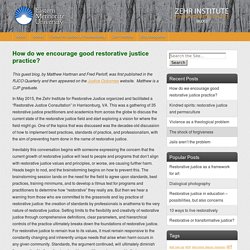
Both fields obscure the unbreakable lifeline between them with oversimplified arguments like social justice versus the environment, jobs versus nature preserves. Fambul Tok Project's channel. Fambul Tok: Post-war community reconciliation drawing on African traditional justice processes. – Fambul Tok. Home - NACRJ - National Association of Community and Restorative Justice.
Promoting quality restorative practice for everyone. African Great Lakes Initiative: Helping to create a more peaceful future in Africa. AGLI Programs AVP: These are three-day experiential workshops that teach participates non-violent means of resolving conflicts.
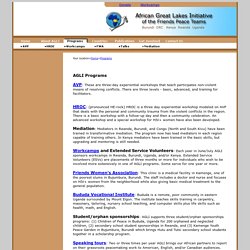
There are three levels - basic, advanced, and training for facilitators. HROC: (pronounced HE-rock) HROC is a three day experiential workshop modeled on AVP that deals with the personal and community trauma from the violent conflicts in the region. There is a basic workshop with a follow-up day and then a community celebration. Past webinars – Webinars – Zehr Institute for Restorative Justice – Center for Justice & Peacebuilding – Eastern Mennonite University. New webinars will resume in September 2014.
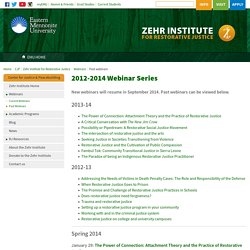
Past webinars can be viewed below. Spring 2014 Guest: Annmarie Early Our understanding of what it means to be human is undergoing rapid change. We are learning that humans use emotion and patterns of connection and disconnection to navigate the world. Guests: Jacqueline Roebuck Sakho, Shiv Desai, and Nekima Levy-Pounds Michelle Alexander’s book, The New Jim Crow: Mass Incarceration in the Age of Color Blindness, has gained widespread attention for its compelling analysis of the relationship between mass incarceration and racism in the U.S. Restorative justice in New Zealand best practice — Ministry of Justice, New Zealand. The need for guidance on the use of restorative justice processes is increasingly recognised.
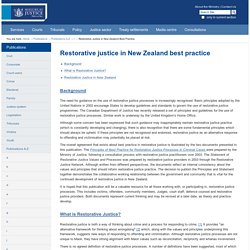
Background The need for guidance on the use of restorative justice processes is increasingly recognised. Basic principles adopted by the United Nations in 2002 encourage States to develop guidelines and standards to govern the use of restorative justice programmes. The Canadian Department of Justice has recently released a set of principles and guidelines for the use of restorative justice processes.
Similar work is underway by the United Kingdom's Home Office. Although some concern has been expressed that such guidance may inappropriately restrain restorative justice practice (which is constantly developing and changing), there is also recognition that there are some fundamental principles which should always be upheld. The overall agreement that exists about best practice in restorative justice is illustrated by the two documents presented in this publication.
Real-discipline-in-school. LAST month, Maryland became one of the first states to tackle the widespread injustice of overly harsh discipline policies in our schools, adopting regulations that require an end to practices that have doubled the number of out-of-school suspensions for African-American students in the past decade.
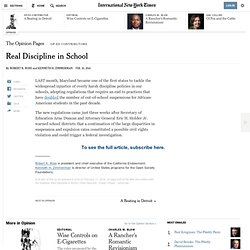
The new regulations came just three weeks after Secretary of Education Arne Duncan and Attorney General Eric H. Holder Jr. warned school districts that a continuation of the large disparities in suspension and expulsion rates constituted a possible civil rights violation and could trigger a federal investigation. But too many schools still use severe and ineffective practices to address student misbehavior. Large numbers of students are kicked out, typically for nonviolent offenses, and suspensions have become the go-to response for even minor misbehavior, like carrying a plastic water gun to elementary school or sometimes simply for talking back. Sex Crimes and RJ. International Institute for Restorative Practices.
Whether you are interested in using restorative practices in education, criminal justice, social work, faith communities, workplaces, youth service settings or as a leadership strategy, this degree will foster a deeper understanding of how to achieve healthy interpersonal and organizational relationships.
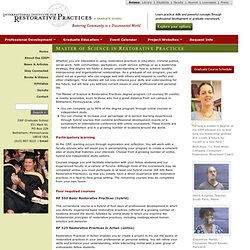
As a graduate of our program, you will stand out as a person who can engage well with others and respond to conflict and other challenges. Your studies will not only enhance your skills and understanding for the future, but will help you address current issues in your professional and personal life. The Master of Science in Restorative Practices degree program (10 courses/30 credits) is readily accessible, even to those who live a great distance from our campus in Bethlehem, Pennsylvania, USA: You can complete up to 90% of the degree program through online courses or independent study.
Participatory learning At the IIRP, learning occurs through exploration and reflection. Admissions. Graduate education & professional development for education, criminal justice, social services, pastoral and other professionals. World Without Hate. Restorative justice goes to school. Schools take different approach to punishment Last updated 05:00 18/02/2012 ANDREW GORRIE/ Fairfax NZ NO SOFT OPTION?
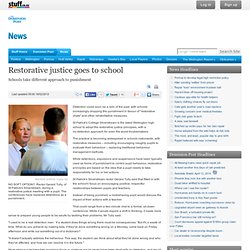
: Rector Gerard Tully, of St Patrick's Silverstream, during a restorative justice meeting with a pupil. The conferences have replaced detentions as a punishment. Detention could soon be a relic of the past, with schools increasingly dropping the punishment in favour of "restorative chats" and other rehabilitative measures. St Patrick's College Silverstream is the latest Wellington high school to adopt the restorative justice principles, with a no-detention approach for even the worst troublemakers. The practice is becoming widespread in schools nationwide, with restorative measures – including encouraging naughty pupils to evaluate their behaviour – replacing traditional behaviour management methods. St Patrick's Silverstream rector Gerard Tully said that fitted in with the school's focus on encouraging positive, respectful relationships between pupils and teachers.
Comments. Mennonite Central Committee - U.S. As followers of Jesus, we are called to an ethic of loving our enemies (Matthew 5:43-48) and to a ministry of reconciliation (2 Corinthians 5:16-20).

MCC U.S. restorative justice work builds capacity to respond in healthy ways to harm and conflict, respond to and prevent violence and sexual abuse in our families and communities, and support healing and promote mutuality through biblical reflection and practices which create life-giving spaces in communities. Emerging out of MCC’s history and experience in Mennonite Conciliation Services and the Office on Crime and Justice, our purpose is to equip people to live in community and to respond redemptively to interpersonal and systemic conflict, harm and injustice within families, communities and congregations.
James Madison. Monday - Friday8:00 AM - 12:001:00 PM - 5:00 Restorative Justice A restorative justice process is one in which the parties with a stake in a particular offense (the victim, the offender, and community members) are supported and voluntarily participate, with the assistance of facilitator, in a discussion of the circumstances surrounding the harm.

The purpose is to understand its underlying causes, the effects on those who have been harmed, and to address the parties’ needs for healing and reparation. Restorative Justice provides opportunities to ask and answer questions, share stories, express feelings, and hopefully develop a better understanding of the other. Office of Student Conduct. Restorative Justice is a theory for how to deal with violations of law, policies and norms.
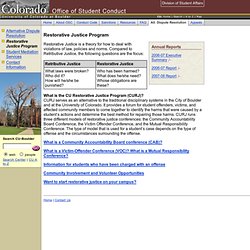
Compared to Retributive Justice, the following questions are the focus: What is the CU Restorative Justice Program (CURJ)? CURJ serves as an alternative to the traditional disciplinary systems in the City of Boulder and at the University of Colorado. It provides a forum for student offenders, victims, and affected community members to come together to identify the harms that were caused by a student’s actions and determine the best method for repairing those harms. CURJ runs three different models of restorative justice conferences: the Community Accountability Board Conference, the Victim Offender Conference, and the Mutual Responsibility Conference. RESTTA National Directory. National Institute of Justice. This page is archived material and is no longer updated. It may contain outdated information and broken links. The material presented on these pages is the product of five regional symposia held on restorative justice between June 1997 and January 1998.
University of Minnesota Center for Restorative Justice and Peacemaking. Victim Offender Mediation Association home page. Restorative Justice- Higher Ed. Restorative Justice Bibliography. Restorativesolutions - experts in conflict resolution, Robert I. Goldman, Attoney, Psychologist, New York. Bridges to Life Restorative Justice Program PBS Video. Restorative Justice Evaluation - Dennis Maloney. Restorative Justice Continuum - Howard Zehr Ph.D EMU. Unexpected Peace. Sycamore Tree Project® — Prison Fellowship International. The Sycamore Tree Project® brings together unrelated victims and offenders (that is, they are not each others' victims and offenders). Using a curruculum guide prepared by PFI, a facilitator leads the participants to consider concepts of responsibility, confession, repentance, forgiveness, amends and reconciliation in the context of crime and justice.
The programme can have profound effects on the victims and offenders. Many victims have reported receiving a measure of healing. Offenders confront, many times for the first time, the harm their actions have had on other people. Studies have shown that offenders who go through the Sycamore Tree Project have significant changes in attitudes that make it less likely they will reoffend once released. What is the Sycamore Tree Project® ? Victim Offender Reconciliation Program VORP. Fresno. RJ India Radio pt 4. RJ India Radio pt. 3. RJ India Radio pt 2. The Restorative Justice Project and Project Trust in India, radio program, 2012, pt 1. RJ Online.